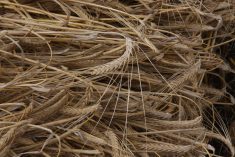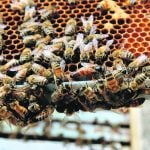According to the Canada Grain Act, there is zero tolerance for primary insects – those that feed on whole grain – in grain delivered to elevators. Prevention is the easiest, safest and least expensive way to achieve an insect-free state.
Before storing grain in the bin, for example, storage and transport facilities should be thoroughly cleaned and, if necessary, sprayed with a recommended insecticide such as a one-percent solution of malathion.
“But, while clean storage will eliminate one source of infestation, grain stored for long periods still has the potential for renewed infestations,” said Scott Hartley, insect control specialist, Saskatchewan Agriculture.
Read Also

Feedgrain prices expected to plummet
A massive U.S. corn crop is keeping a lid on Canadian feed barley prices.
“Ideally, the grain should be dry before being put into storage and cooled as quickly as possible.”
Hartley said most stored-grain insects cannot multiply at temperatures below 18 C.
Cooling the grain through aeration or moving the grain several times in mid-winter should control rusty grain beetles, the most common stored-grain insect. Moving the grain using pneumatic conveyors (grain vacs) has also been shown to be an effective means of controlling free, live insects in stored grain.
“Regular monitoring of stored grain is also necessary, as damaged kernels or insect sightings will indicate a problem. As always, correct identification of insects can be important in determining the problems and possible solutions. Some of the insects in stored grain feed on the grains, for example, while others feed on fungus that may be developing in the stored grain,” said Hartley.
Most common pests
Insects that feed on the grain include the rusty grain beetle, a flat, two-millimetre-long, rectangular and reddish-brown bug. Heavy infestations cause grain to heat and spoil.
Another common insect pest of stored grain is the red flour beetle, which is reddish-brown and four mm long. It cannot feed on undamaged dry seed with less than 12 percent moisture content.
It prefers grain dust, broken grain and milled stocks.
Adult saw-toothed grain beetles are brown, about three mm long and have six teeth like projections on each side of the thorax. They are more common in stored oats than in stored wheat and barley.
Fungus eaters
Insects that feed on fungus in the grain bin include the foreign grain beetle and grain mites. Adult foreign grain beetles resemble the rusty grain beetle but, unlike them, can climb up the sides of a glass jar. There are about eight kinds of mites common in farm granaries and elevators, all difficult to see with the naked eye.
“Fungus-feeding insects and mites cannot survive in dry grain, so grain-drying practices may be all that is needed to control them,” said Hartley.
Rusty grain beetles and other stored-grain insects can be killed by reducing core grain temperatures for a specified time period: six weeks are needed to kill insects at -5 C; four weeks to kill at -10 C; and two weeks to kill at -15 C.
It is also important to note, particularly during an extended fall or if bins are still full the following spring, that maintaining core grain temperatures below 18 C will stop beetles from reproducing and laying eggs; below 15 C will limit movement and feeding activities.
If, after cleaning the bins and cooling the grain, an insect problem occurs, there are several solutions. Phostoxin and gastoxin are two fumigants available as pellets or tablets that can be applied to a variety of stored crops.
If the grain is less than 5 C, however, the tablets will not release the gas until the grain temperature warms up.
Protect-It, a diatomaceous earth formulation, is now registered for control of rusty grain beetles in wheat. It reduces the insect’s ability to retain moisture, causing it to die from dehydration.
But the insects must be active, and DE is most effective when used in dry grain. DE is non-toxic to humans and animals at application rates.
Malathion Grain Protectant Dust is registered for use in wheat, rye, barley and oats and is only effective if the insects are active.
It cannot be applied within seven days of the grain sale.
















